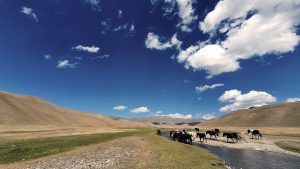Over the course of 2023, Central Asia grappled with escalating challenges stemming from climate change, including disruptive weather patterns affecting long-standing agricultural practices and the melting of key glaciers impacting water resources. It was a particularly challenging year for the region.
For instance, in mid-summer 2023, Turkmenistan turned off fountains in the capital, citing a lack of water. In other parts of the country, locals consistently struggle with unsustainable fresh water supplies, live without fresh water for weeks, and are forced to buy water with their dwindling financial resources.
In June 2023, Kazakhstan declared a state of emergency in Aktau as Caspian Sea water levels dropped to a critically low level. When residents of Astana organized an impromptu rally in the city center in July, they chanted “Give us water!”
Kyrgyzstan and Uzbekistan have not been spared either. Residents of Bishkek staged small-scale rallies in the summer and the city government banned car washes, swimming pools, and bathhouses. In Uzbekistan, fresh water prices doubled in some regions.
The Central Asian water crisis, the product of climate change, inefficient water management, and growing water consumption, is not just a hypothetical problem anymore – it is affecting all parts of the region, and it is happening now. The past year underscored a pressing need for comprehensive and sustainable climate action, prompting an exploration of adaptive strategies and the fostering of collaborative efforts to mitigate far-reaching consequences on both ecosystems and local communities.
The Intergovernmental Panel on Climate Change (IPCC) reports Central Asia to be highly vulnerable to climate change given that the temperature in the region is rising faster than the global average. Between 1990 and 2020, the average annual temperature in some areas of Central Asia was at least 5 degrees Celsius warmer than it had been from 1960 to 1979, with summers becoming drier and winters characterized by more rain. Projected climate models consistently indicate a warming trend, with average annual temperatures predicted to increase by 3-5 degrees C by 2080.
As temperatures rise, livestock health is affected by heat stress, metabolic disorders, oxidative stress, and immune suppression, resulting in increased disease and mortality. For instance, in 2021, widespread droughts caused massive losses in livestock in western Kazakhstan, leading to at least 500 dead cattle in one village alone. Scientists predict that it will not be long until climate change leads to a further decrease in food availability across the entire region.
The agricultural sector makes significant contributions to Central Asian economies: 5.2 percent of GDP in Kazakhstan; 7.5 percent in Turkmenistan; 18.5 percent in Uzbekistan; 20.8 percent in Kyrgyzstan; and 23.3 percent in Tajikistan. In light of this, recent crop failures, caused by a heatwave and drought, will inevitably affect the region’s economies and its potential for growth and development.
A further climate-related strain on Central Asian economies is migration. A 2021 report from the World Bank estimated that the region could see as many as 5 million internal climate migrants by 2050.

































